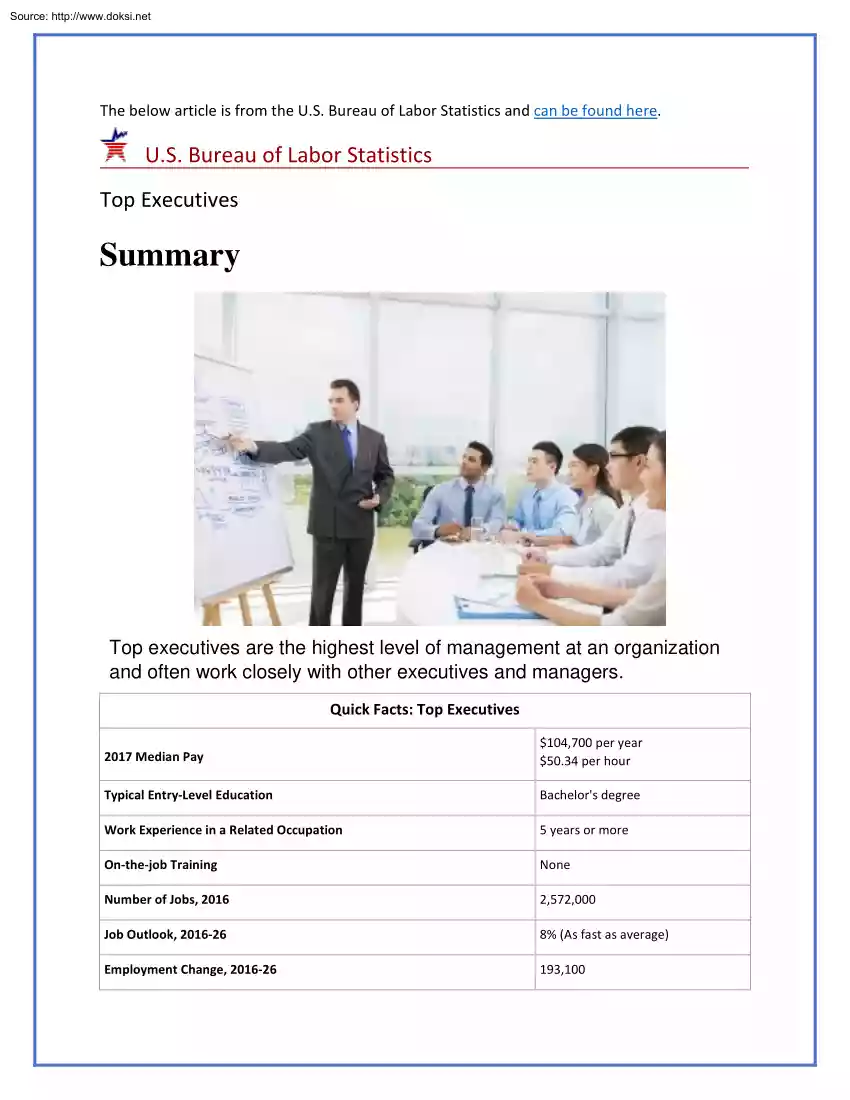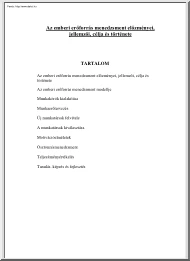Datasheet
Year, pagecount:2018, 9 page(s)
Language:English
Downloads:2
Uploaded:April 29, 2019
Size:688 KB
Institution:
-
Comments:
U.S. Bureau of Labor Statistics
Attachment:-
Download in PDF:Please log in!
Comments
No comments yet. You can be the first!Content extract
Source: http://www.doksinet The below article is from the U.S Bureau of Labor Statistics and can be found here U.S Bureau of Labor Statistics Top Executives Summary Top executives are the highest level of management at an organization and often work closely with other executives and managers. Quick Facts: Top Executives 2017 Median Pay $104,700 per year $50.34 per hour Typical Entry-Level Education Bachelors degree Work Experience in a Related Occupation 5 years or more On-the-job Training None Number of Jobs, 2016 2,572,000 Job Outlook, 2016-26 8% (As fast as average) Employment Change, 2016-26 193,100 Source: http://www.doksinet What Top Executives Do Top executives devise strategies and policies to ensure that an organization meets its goals. They plan, direct, and coordinate operational activities of companies and organizations. Work Environment Top executives work in nearly every industry. They work for both small and large businesses, ranging from companies in
which they are the only employee to firms with hundreds of thousands of employees. Top executives often work many hours, including evenings and weekends. In 2016, about half worked more than 40 hours per week Travel is common, particularly for chief executives. How to Become a Top Executive Although education and training requirements vary widely by position and industry, most top executives have at least a bachelor’s degree and a considerable amount of work experience. Pay The median annual wage for chief executives was $183,270 in May 2017. The median annual wage for general and operations managers was $100,410 in May 2017. Job Outlook Overall employment of top executives is projected to grow 8 percent from 2016 to 2026, about as fast as the average for all occupations. Employment growth will vary by occupation and industry, and is largely dependent on the rate of industry growth. Top executives are expected to face very strong competition for jobs. State & Area Data Explore
resources for employment and wages by state and area for top executives. Similar Occupations Compare the job duties, education, job growth, and pay of top executives with similar occupations. More Information, Including Links to O*NET Learn more about top executives by visiting additional resources, including O*NET, a source on key characteristics of workers and occupations. Source: http://www.doksinet What Top Executives Do Top executives often report to a board of directors. Top executives devise strategies and policies to ensure that an organization meets its goals. They plan, direct, and coordinate operational activities of companies and organizations. Duties Top executives typically do the following: Establish and carry out departmental or organizational goals, policies, and procedures Direct and oversee an organization’s financial and budgetary activities Manage general activities related to making products and providing services Consult with other executives, staff, and
board members about general operations Negotiate or approve contracts and agreements Appoint department heads and managers Analyze financial statements, sales reports, and other performance indicators Identify places to cut costs and to improve performance, policies, and programs The responsibilities of top executives largely depend on an organization’s size. For example, an owner or manager of a small organization, such as an independent retail store, often is responsible for purchasing, hiring, training, quality control, and day-today supervisory duties. In large organizations, however, top executives typically focus more on formulating policies and strategic planning, while general and operations managers direct day-to-day operations. The following are examples of types of top executives: Source: http://www.doksinet General and operations managers oversee operations that are too diverse and general to be classified into one area of management or administration. Responsibilities
may include formulating policies, managing daily operations, and planning the use of materials and human resources. They make staff schedules, assign work, and ensure that projects are completed In some organizations, the tasks of chief executive officers may overlap with those of general and operations managers. Chief executive officers (CEOs), who are also known by titles such as executive director, managing director, or president, provide overall direction for companies and organizations. CEOs manage company operations, formulate and implement policies, and ensure goals are met. They collaborate with and direct the work of other top executives and typically report to a board of directors. There may be other types of chief executives, for example chief operating officers (COOs), chief financial officers (CFOs), or chief human resources officers, who manage a specific part of the business organization. The knowledge, skills, and job duties that these executives have will differ
depending on what department they oversee. Job titles may vary in the public sector or in the education industry. The following are examples of types of top executives working in the public sector for local and state governments: Mayors, along with governors, city managers, and county administrators, are chief executive officers of governments. They typically oversee budgets, programs, and the use of resources Mayors and governors must be elected to office, whereas managers and administrators are typically appointed. Most educational systems, regardless of whether they are public or private school systems, also employ executive officers. The following are examples of top executives working in the elementary, secondary, and postsecondary educational school systems: School superintendents and college or university presidents are chief executive officers of school districts and postsecondary schools. They manage issues such as student achievement, budgets and resources, general
operations, and relations with government agencies and other stakeholders. Source: http://www.doksinet Work Environment Top executives often work many hours, including evenings and weekends. Chief executives held about 308,900 jobs in 2016. The largest employers of chief executives were as follows: Self-employed workers 23% Professional, scientific, and technical services 8 Government 8 Manufacturing 7 Healthcare and social assistance 7 General and operations managers held about 2.3 million jobs in 2016 The largest employers of general and operations managers were as follows: Retail trade 12% Professional, scientific, and technical services 11 Manufacturing 10 Wholesale trade 8 Construction 7 Top executives work in nearly every industry. They work for both small and large businesses, ranging from companies in which they are the sole employee to firms with hundreds of thousands of employees. Source: http://www.doksinet Because top executives are responsible for
the success of a business, the work is often stressful. Executives in charge of poorly performing organizations or departments may find their jobs in jeopardy. Top executives frequently travel to attend meetings and conferences or to visit their company’s local, regional, national, and international offices. Top executives often spend time interacting with other high-level executives of the company, for example financial managers, human resource managers, or chief technology officers. Pay Top Executives Median annual wages, May 2017 Chief executives $183,270 Top executives $104,700 Management occupations $102,590 General and operations managers Total, all occupations $100,410 $37,690 Note: All Occupations includes all occupations in the U.S Economy Source: U.S Bureau of Labor Statistics, Occupational Employment Statistics The median annual wage for chief executives was $183,270 in May 2017. The median wage is the wage at which half the workers in an occupation earned
more than that amount and half earned less. The lowest 10 percent earned less than $68,110, and the highest 10 percent earned more than $208,000. The median annual wage for general and operations managers was $100,410 in May 2017. The lowest 10 percent earned less than $44,510, and the highest 10 percent earned more than $208,000. Source: http://www.doksinet In May 2017, the median annual wages for chief executives in the top industries in which they worked were as follows: Professional, scientific, and technical services Manufacturing Healthcare and social assistance Government $208,000 or more 208,000 or more 160,940 107,130 In May 2017, the median annual wages for general and operations managers in the top industries in which they worked were as follows: Professional, scientific, and technical services $137,950 Manufacturing 114,330 Wholesale trade 108,960 Construction 101,200 Retail trade 73,760 Because the responsibilities of general and operations managers vary significantly
among industries, earnings also tend to vary considerably. Top executives are among the highest paid workers in the United States. However, salary levels can vary substantially. For example, a top manager in a large corporation can earn significantly more than the mayor of a small town. In addition to salaries, total compensation for corporate executives often includes stock options and other performance bonuses. They also may enjoy benefits, such as access to expense allowances, use of company-owned aircraft and cars, and membership to exclusive clubs. Nonprofit and government executives usually receive fewer of these types of incentives. Top executives often work many hours, including evenings and weekends. In 2016, about half worked more than 40 hours per week. Source: http://www.doksinet Job Outlook Top Executives Percent change in employment, projected 2016-26 General and operations managers 9% Management occupations 8% Top executives 8% Total, all occupations Chief
executives 7% -4% Note: All Occupations includes all occupations in the U.S Economy Source: U.S Bureau of Labor Statistics, Employment Projections program Overall employment of top executives is projected to grow 8 percent from 2016 to 2026, about as fast as the average for all occupations. Employment growth will vary widely by occupation (see table below) and industry, and is largely dependent on the rate of industry growth. Top executives are essential for running companies and organizations and their work is central to the success of a company. Generally, employment growth will be driven by the formation of new organizations and expansion of existing ones, which will require more managers and executives to direct these operations. However, improving office technology and changing organizational structures have increased the ability of the chief executive officer to manage the day-to-day operations of a business. In addition, the rate of new firm creation has slowed in recent
years, with economic activity and employment becoming increasingly concentrated in larger, more mature companies. The demand for chief executives is projected to decline slightly because of the expectation that these trends are likely to continue over the next ten years. Source: http://www.doksinet Contacts for More Information For more information about top executives, including educational programs, visit American Management Association National Management Association For more information about executive financial management careers, visit Financial Executives International Financial Management Association International For career videos on top executives, visit Chief Executives O*NET Chief Executives Chief Sustainability Officers General and Operations Managers Suggested citation: Bureau of Labor Statistics, U.S Department of Labor, Occupational Outlook Handbook, Top Executives, on the Internet athttps://www.blsgov/ooh/management/top-executiveshtm (visited May 22, 2018) Last
Modified Date: Friday, April 13, 2018 U.S Bureau of Labor Statistics | Office of Occupational Statistics and Employment Projections, PSB Suite 2135, 2 Massachusetts Avenue, NE Washington, DC 20212-0001 www.blsgov/ooh | Telephone: 1-202-691-5700 | Contact OOH
which they are the only employee to firms with hundreds of thousands of employees. Top executives often work many hours, including evenings and weekends. In 2016, about half worked more than 40 hours per week Travel is common, particularly for chief executives. How to Become a Top Executive Although education and training requirements vary widely by position and industry, most top executives have at least a bachelor’s degree and a considerable amount of work experience. Pay The median annual wage for chief executives was $183,270 in May 2017. The median annual wage for general and operations managers was $100,410 in May 2017. Job Outlook Overall employment of top executives is projected to grow 8 percent from 2016 to 2026, about as fast as the average for all occupations. Employment growth will vary by occupation and industry, and is largely dependent on the rate of industry growth. Top executives are expected to face very strong competition for jobs. State & Area Data Explore
resources for employment and wages by state and area for top executives. Similar Occupations Compare the job duties, education, job growth, and pay of top executives with similar occupations. More Information, Including Links to O*NET Learn more about top executives by visiting additional resources, including O*NET, a source on key characteristics of workers and occupations. Source: http://www.doksinet What Top Executives Do Top executives often report to a board of directors. Top executives devise strategies and policies to ensure that an organization meets its goals. They plan, direct, and coordinate operational activities of companies and organizations. Duties Top executives typically do the following: Establish and carry out departmental or organizational goals, policies, and procedures Direct and oversee an organization’s financial and budgetary activities Manage general activities related to making products and providing services Consult with other executives, staff, and
board members about general operations Negotiate or approve contracts and agreements Appoint department heads and managers Analyze financial statements, sales reports, and other performance indicators Identify places to cut costs and to improve performance, policies, and programs The responsibilities of top executives largely depend on an organization’s size. For example, an owner or manager of a small organization, such as an independent retail store, often is responsible for purchasing, hiring, training, quality control, and day-today supervisory duties. In large organizations, however, top executives typically focus more on formulating policies and strategic planning, while general and operations managers direct day-to-day operations. The following are examples of types of top executives: Source: http://www.doksinet General and operations managers oversee operations that are too diverse and general to be classified into one area of management or administration. Responsibilities
may include formulating policies, managing daily operations, and planning the use of materials and human resources. They make staff schedules, assign work, and ensure that projects are completed In some organizations, the tasks of chief executive officers may overlap with those of general and operations managers. Chief executive officers (CEOs), who are also known by titles such as executive director, managing director, or president, provide overall direction for companies and organizations. CEOs manage company operations, formulate and implement policies, and ensure goals are met. They collaborate with and direct the work of other top executives and typically report to a board of directors. There may be other types of chief executives, for example chief operating officers (COOs), chief financial officers (CFOs), or chief human resources officers, who manage a specific part of the business organization. The knowledge, skills, and job duties that these executives have will differ
depending on what department they oversee. Job titles may vary in the public sector or in the education industry. The following are examples of types of top executives working in the public sector for local and state governments: Mayors, along with governors, city managers, and county administrators, are chief executive officers of governments. They typically oversee budgets, programs, and the use of resources Mayors and governors must be elected to office, whereas managers and administrators are typically appointed. Most educational systems, regardless of whether they are public or private school systems, also employ executive officers. The following are examples of top executives working in the elementary, secondary, and postsecondary educational school systems: School superintendents and college or university presidents are chief executive officers of school districts and postsecondary schools. They manage issues such as student achievement, budgets and resources, general
operations, and relations with government agencies and other stakeholders. Source: http://www.doksinet Work Environment Top executives often work many hours, including evenings and weekends. Chief executives held about 308,900 jobs in 2016. The largest employers of chief executives were as follows: Self-employed workers 23% Professional, scientific, and technical services 8 Government 8 Manufacturing 7 Healthcare and social assistance 7 General and operations managers held about 2.3 million jobs in 2016 The largest employers of general and operations managers were as follows: Retail trade 12% Professional, scientific, and technical services 11 Manufacturing 10 Wholesale trade 8 Construction 7 Top executives work in nearly every industry. They work for both small and large businesses, ranging from companies in which they are the sole employee to firms with hundreds of thousands of employees. Source: http://www.doksinet Because top executives are responsible for
the success of a business, the work is often stressful. Executives in charge of poorly performing organizations or departments may find their jobs in jeopardy. Top executives frequently travel to attend meetings and conferences or to visit their company’s local, regional, national, and international offices. Top executives often spend time interacting with other high-level executives of the company, for example financial managers, human resource managers, or chief technology officers. Pay Top Executives Median annual wages, May 2017 Chief executives $183,270 Top executives $104,700 Management occupations $102,590 General and operations managers Total, all occupations $100,410 $37,690 Note: All Occupations includes all occupations in the U.S Economy Source: U.S Bureau of Labor Statistics, Occupational Employment Statistics The median annual wage for chief executives was $183,270 in May 2017. The median wage is the wage at which half the workers in an occupation earned
more than that amount and half earned less. The lowest 10 percent earned less than $68,110, and the highest 10 percent earned more than $208,000. The median annual wage for general and operations managers was $100,410 in May 2017. The lowest 10 percent earned less than $44,510, and the highest 10 percent earned more than $208,000. Source: http://www.doksinet In May 2017, the median annual wages for chief executives in the top industries in which they worked were as follows: Professional, scientific, and technical services Manufacturing Healthcare and social assistance Government $208,000 or more 208,000 or more 160,940 107,130 In May 2017, the median annual wages for general and operations managers in the top industries in which they worked were as follows: Professional, scientific, and technical services $137,950 Manufacturing 114,330 Wholesale trade 108,960 Construction 101,200 Retail trade 73,760 Because the responsibilities of general and operations managers vary significantly
among industries, earnings also tend to vary considerably. Top executives are among the highest paid workers in the United States. However, salary levels can vary substantially. For example, a top manager in a large corporation can earn significantly more than the mayor of a small town. In addition to salaries, total compensation for corporate executives often includes stock options and other performance bonuses. They also may enjoy benefits, such as access to expense allowances, use of company-owned aircraft and cars, and membership to exclusive clubs. Nonprofit and government executives usually receive fewer of these types of incentives. Top executives often work many hours, including evenings and weekends. In 2016, about half worked more than 40 hours per week. Source: http://www.doksinet Job Outlook Top Executives Percent change in employment, projected 2016-26 General and operations managers 9% Management occupations 8% Top executives 8% Total, all occupations Chief
executives 7% -4% Note: All Occupations includes all occupations in the U.S Economy Source: U.S Bureau of Labor Statistics, Employment Projections program Overall employment of top executives is projected to grow 8 percent from 2016 to 2026, about as fast as the average for all occupations. Employment growth will vary widely by occupation (see table below) and industry, and is largely dependent on the rate of industry growth. Top executives are essential for running companies and organizations and their work is central to the success of a company. Generally, employment growth will be driven by the formation of new organizations and expansion of existing ones, which will require more managers and executives to direct these operations. However, improving office technology and changing organizational structures have increased the ability of the chief executive officer to manage the day-to-day operations of a business. In addition, the rate of new firm creation has slowed in recent
years, with economic activity and employment becoming increasingly concentrated in larger, more mature companies. The demand for chief executives is projected to decline slightly because of the expectation that these trends are likely to continue over the next ten years. Source: http://www.doksinet Contacts for More Information For more information about top executives, including educational programs, visit American Management Association National Management Association For more information about executive financial management careers, visit Financial Executives International Financial Management Association International For career videos on top executives, visit Chief Executives O*NET Chief Executives Chief Sustainability Officers General and Operations Managers Suggested citation: Bureau of Labor Statistics, U.S Department of Labor, Occupational Outlook Handbook, Top Executives, on the Internet athttps://www.blsgov/ooh/management/top-executiveshtm (visited May 22, 2018) Last
Modified Date: Friday, April 13, 2018 U.S Bureau of Labor Statistics | Office of Occupational Statistics and Employment Projections, PSB Suite 2135, 2 Massachusetts Avenue, NE Washington, DC 20212-0001 www.blsgov/ooh | Telephone: 1-202-691-5700 | Contact OOH





 When reading, most of us just let a story wash over us, getting lost in the world of the book rather than paying attention to the individual elements of the plot or writing. However, in English class, our teachers ask us to look at the mechanics of the writing.
When reading, most of us just let a story wash over us, getting lost in the world of the book rather than paying attention to the individual elements of the plot or writing. However, in English class, our teachers ask us to look at the mechanics of the writing.